
Hello Friends,
Although the 2024 Legislative Short Session has ended, there is still much work to be done. The interim is filled with work for constituents, industries and bridging the gaps to agencies.
Although we have 60 State Representatives in the House; 25 of which are Republicans, and 30 State Senators; 13 of which are Republicans, we were able to stop a number of bills that would have negatively impacted our residents, their communities and the industries that support them. This is a testament to the work we can accomplish when we work together, even though we don't have the numbers to stop a piece of legislation as the majority currently has the votes to pass whatever they would like. Legislation like the ones we stopped below will likely be back in the 2025 Legislative Session and we must continue to be diligent and be prepared to work again to stop them.
I will continue to put together my Bills of Concern/Bills to Support lists in the upcoming 2025 Legislative Session. I want to thank you for all of your incredible advocacy and support by providing testimony that helped my legislative colleagues and I stop these bad bills.
Some Bad Bills That Died
HB 4159 - Makes the office charged with helping persons who are new to the U.S. and Oregon award contracts to entities to provide the persons with support services. Creates a council to advise the office on the support services. Makes the office conduct an annual audit of groups providing the support services. (Flesch Readability Score: 61.3). Requires the Office of Immigrant and Refugee Advancement to contract with entities to provide eligible newcomers with case management, short-term and long-term support services. Defines "eligible newcomers." Creates an advisory council to serve as a forum for sharing information and to advise the office on the provision of the support services. Directs the office to conduct an annual performance audit of each entity contracted by the office to provide the support services. Declares an emergency, effective on passage.
HB 4085 - Directs DHS to give grants to help noncitizens get lawful immigration status. The Act goes into effect on the 91st day after session ends. (Flesch Readability Score: 60.7). Directs the Department of Human Services to provide grants to assist individuals who are noncitizens and who do not possess valid immigration documentation to change their immigration status or obtain lawful permanent resident status. Takes effect on the 91st day following adjournment sine die.
SB 1559 – This Act changes the state's greenhouse gas emissions reduction goals. The Act changes the term "global warming" to "climate change" in some laws. The Act declares an emergency and takes effect when it passes. (Flesch Readability Score: 68.4). Modifies state greenhouse gas emissions reduction goals. Replaces the term "global warming" with "climate change" in provisions related to the Oregon Climate Action Commission. Declares an emergency, effective on passage.
HB 4005 - The Act makes changes to state law to clarify the meaning of an individual's performance of services. The Act takes effect 91 days after session ends. (Flesch Readability Score: 63.4). Clarifies when an employee is employed by employing unit or employer for a single hour of work for purposes of unemployment insurance and paid family and medical leave programs. Requires the Director of the Employment Department to issue a refund to a paying entity that paid the employer contribution amounts on behalf of an employer with respect to employees for hours of work in which the employees did not perform services for the paying entity. Takes effect on the 91st day following adjournment sine die.
SB 1577 - The Act allows people to register to vote when they apply for college. The Act tells the DOR to provide the SOS with records related to voter registration. (Flesch Readability Score: 64.6). Extends automatic voter registration to applicants for admission to public institutions of higher education. Requires the Department of Revenue to provide the Secretary of State with records containing information related to voter registration.
HJR 201 - The Act would put in the constitution a state tax on property to fund public safety. (Flesch Readability Score: 63.6). Proposes an amendment to the Oregon Constitution requiring the Legislative Assembly to create an administrative authority for funding public safety in this state. Directs the Legislative Assembly to impose a state property tax to fund public safety in this state. Allows the Legislative Assembly to delegate to the administrative authority the authority to implement the tax. Provides that the tax would not be subject to Article XI, section 11, of the Oregon Constitution (Ballot Measure 50) (1997), or Article XI, section 11b, of the Oregon Constitution (Ballot Measure 5) (1990). Refers the proposed amendment to the people for their approval or rejection at the next regular general election.
***MAJOR THREAT TO FOREST LANDOWNERS/WOOD PRODUCTS***
SB 1593 - The Act would impose a new tax on the gross proceeds from the sale of unprocessed timber cut on private land larger than 500 acres held in common ownership. The Act would provide funding to counties and to protect homes, neighborhoods and water supplies from wildfire damage. The Act would repeal the current forest products harvest tax. The Act will be referred to the people at the 2024 general election. (Flesch Readability Score: 63.3). Imposes a new tax on the gross proceeds from the sale of unprocessed timber harvested on private land in excess of 500 acres held in common ownership in this state. Repeals the current forest products harvest tax regime. Refers the Act to the people for their approval or rejection at the next general election.
HB 4130 B – Stops people in charge of companies that do medical work from running both the company and other business that does work that is not medical work. Stops the people in charge from hiring, firing or telling medical workers when and how to do their jobs. Stops companies from giving control of the company to other businesses that do work that is not medical work. Lets the Secretary of State punish bad actors. Stops companies that give medical care from telling their workers that they cannot work for someone else, say that the company is bad or speak out about the company's bad acts. Stops companies from punishing those who speak out. (Flesch Readability Score: 60.7). Prohibits a shareholder, director or officer of a domestic or foreign professional corporation organized for the purpose of practicing medicine or naturopathic medicine, or for the purpose of allowing physicians, physician assistants and nurse practitioners to jointly render professional health care services, from owning or controlling shares in, serving as a director or officer of, being an employee or contractor of or otherwise participating in managing both the professional corporation and a management services organization with which the professional corporation has a contract. Prohibits shareholders, directors or officers from participating in hiring, terminating or specifying the terms of employment for medical professionals that the professional corporation employs or with which the professional corporation has a contract for services while owning or controlling shares in, serving as a director of or being an employee or contractor of a management services organization with which the professional corporation has a contract. Specifies exceptions. Prohibits a professional corporation from relinquishing or transferring control over the professional corporation's assets, business operations, clinical practices or decisions or the clinical practices or decisions of medical professionals the professional corporation employs or with which the professional corporation has a contract. Specifies examples of prohibited methods of transferring control and exceptions to the prohibition. Provides that requirements that apply to domestic and foreign professional corporations organized for the purpose of practicing medicine or naturopathic medicine, or for the purpose of allowing physicians, physician assistants and nurse practitioners to jointly render professional health care services, also apply to domestic and foreign limited liability companies, partnerships, limited partnerships and limited liability partnerships organized for a medical purpose. Provides the Secretary of State with authority to enforce violations of the requirements by administratively dissolving or revoking or inactivating the registration of entities that engage in violations. Voids noncompetition agreements, nondisclosure agreements and nondisparagement agreements between certain business entities and medical professionals, with specified exceptions, and prohibits the business entities from retaliating against the medical professional for violating the void agreements. Punishes retaliations as an unlawful employment practice. Takes effect on the 91st day following adjournment sine die.
I recommend that you read the opposition testimony in the links below to see how this legislation will hurt our small medical practices and providers in our rural communities.
https://olis.oregonlegislature.gov/liz/2024R1/Downloads/PublicTestimonyDocument/114684
https://olis.oregonlegislature.gov/liz/2024R1/Downloads/PublicTestimonyDocument/115239
https://olis.oregonlegislature.gov/liz/2024R1/Downloads/PublicTestimonyDocument/114446
https://olis.oregonlegislature.gov/liz/2024R1/Downloads/PublicTestimonyDocument/114492
https://olis.oregonlegislature.gov/liz/2024R1/Downloads/PublicTestimonyDocument/114508
https://olis.oregonlegislature.gov/liz/2024R1/Downloads/PublicTestimonyDocument/114699
SB 1583 was a bill that would have taken away school choice in a number of ways, from age appropriate books in school libraries to choice on educational materials in our districts for our students. I have posted below what I sent out on the bill on February 18th. It was critically important that we stopped this legislation from taking away the rights from our local school boards. Click Here to watch my comments on the bill from the Senate Floor.
Last week I issued a ***MAJOR THREAT TO SCHOOL CHOICE AND EDUCATION*** regarding SB 1583 which passed out of committee on a party line vote last week. In today’s Oregonlive/The Oregonian there is an article regarding a study on post pandemic student success done by Harvard and Stanford. Having been a longtime school board member, I have serious concerns with the direction SB 1583 would take our schools across the state. The comments in today’s article below from the Director of the Oregon Department of Education Charlene Williams are clear to me that she wants the bill to move forward. The article however is also clear, that she and her colleagues failed to design guidelines above those that were federal to direct those dollars to increase student success. I am very concerned by this pivot from their failure and encourage your engagement as this legislation moves forward.
Please read the article below or in the link HERE.
Although the Oregon Department of Education and the State Board of Education has not supplied written testimony to date, bringing your respectful voice of opposition to their attention could be meaningful. You can get to the State Board of Education website HERE.
Thank you for all of your continued incredible advocacy on this and other critical issues.
Students nationwide have rebounded after pandemic. But not in Oregon. Consequences could be severe.
- Updated: Feb. 18, 2024, 2:30 p.m.|
- Published: Feb. 18, 2024, 4:00 a.m.
By
Students around the country have shown promising signs of rebounding from the COVID era’s massive disruptions to learning, according to a first-of-its-kind multi-state analysis by researchers at Harvard and Stanford universities.
But not in Oregon.
Unlike in the 29 other states studied, Oregon students as a whole have failed to regain either reading or math skills, researchers found.
The state’s elementary and middle school students remain an average of about two-thirds of a year behind in reading compared to pre-pandemic levels and three-fourths of a year behind in math, the study found. That’s roughly two to three times the deficit faced by students nationwide, the study found.
Those dispiriting results come despite a $1.6 billion infusion of federal pandemic aid to the state’s 197 school districts. That money will run out in eight months, and most Oregon school districts have already spent most of it with little to show for it.
The learning deficits are worst in the poorest pockets of the state, but many comparatively wealthy Portland-area suburban districts have yet to show much bounce-back.
Districts had almost complete leeway to decide how to spend their federal funds. Without parameters from the state or federal government, Oregon districts often chose to pay for online academies, to preserve staff despite enrollment drops and other initiatives that have yet to translate into measurable learning rebounds.
That matters, not just for students and their success in school, but more broadly for Oregon’s economy, crime levels and broader measures of well-being, researchers say.
“The initial [academic] losses in Oregon were among the largest in our study,” said Thomas Kane, faculty director of the Center for Education Policy Research at Harvard University and a co-author of the study, which used state test scores from 2019, 2022 and 2023 and triangulated them against scores on a national exam given in all states in 2019 and 2022. In Oregon, Kane said, “We saw very little evidence of improvement between 2022 and 2023, whereas most states did.”
What went wrong?
Oregon’s poor performance cannot be fully explained by the fact that the state had some of the nation’s longest school closures. Students in California and Washington, where schools were closed for around the same length of time, have shown academic rebounds in math and slimmer continued losses in reading than Oregon.
State education officials could not pinpoint why Oregon students haven’t shown gains, even as students in Illinois, Louisiana and Mississippi are back to performing at 2019 levels in reading and students in Alabama have hit pre-pandemic levels in math. But state schools chief Charlene Williams said Oregon needs to strengthen instruction systemwide.
“What we’ve been doing has not been working,” Williams said. “There are spaces for us to be more consistent across the board. We cannot have 197 school districts doing 197 different things.”
Williams said Oregon’s unusually short school year sets it apart from other states, as does its long tradition of local school district control. Strategies like high-dosage tutoring and summer school are critical, she said, and Oregon “absolutely needs to be doing that,” she said.
But “if 50% to 60% of our students are not performing well, that means our core instruction needs to change,” she said. “We aren’t in a position to provide 60% of our students with one-on-one tutoring or summer programming. So what can we do to reduce the number of students that need those concentrated doses of important supports?”
She pointed to the state’s new early literacy initiative as a promising model: Every district in the state is participating and receiving funding that can only be spent on a tailored band of options, including curricula that stress phonics and phonemic awareness, professional development in foundational literacy and tutoring for struggling readers.
Since the pandemic, it can feel like few students display mid-range skills anymore, said Bryan Sager, a veteran fifth grade teacher at Cherry Park Elementary School in the David Douglas School District at Portland’s eastern edge. Some of his students are academic high-flyers, he said, while many others have significant knowledge gaps.
He has students who still struggle to grasp concepts like basic division, he said, so he needs to reteach that lesson, sometimes repeatedly. That’s despite the fact the curriculum schedule calls for him to be teaching students how to divide fractions and reduce the answer using lowest common denominators at this point in the year.
Sager said he lingers on must-know topics, sometimes at the expense of others, in hopes of making sure his students have the basics down by year’s end. He wants to give them at least a fighting chance in middle school.
He and other grade-level teachers meet weekly to compare notes and help each other maximize progress. They share quiz results and other student work to see where persistent mistakes crop up, so they can precisely target how to help different groups of students.
“There are just holes that need to be filled,” he said. “We have to fill those holes, not push them along, or the kids that have holes will get even more behind.”
Where did the money go?
An analysis of pandemic relief spending in Oregon’s 10 largest school districts by nonprofit education advocacy group Stand for Children Oregon suggests those districts directed relatively little of the money to the handful of strategies that research has found most helpful to catch students back up. Those include frequent small-group tutoring, academically rigorous summer school, extending the school year and expanded training opportunities for educators.
The infusion of federal money was intended to mitigate impacts of the pandemic on students’ learning and well-being, not to shore up day-to-day operations or fund capital projects.
Kane said a few states did offer districts concrete directions about how they should spend the federal money. In Tennessee, the state offered matching funds to districts that spent their funds on high-impact tutoring -- help for no more than three students at a time, with the same tutor, at least three times a week for half an hour or more. The state’s effort has reached 150,000 students and the benefits to their achievement have been profound, particularly among poorer students, the researchers found.
In Oregon, as in most states, there was only one requirement for spending the huge dose of federal aid: 20% had to go towards academic recovery. And that was essentially meaningless, as each district was left to decide what academic recovery meant.
As a result, there was little consensus about which interventions should be classified as helping students catch up, which proved detrimental, said Sarah Pope, the executive director of Stand for Children Oregon.
“Oregon’s results are unacceptable. Our educators and children are just as talented as the educators and children in every other state,” Pope said. She decried the lack of “a statewide, focused, research-based strategy. The research is clear on what accelerates student learning, and our state didn’t insist we do that with these funds.”
Among the 10 largest districts in the state, Salem-Keizer and Gresham spent millions of the federal dollars to keep class sizes low, preserving some teaching jobs that otherwise would have been pruned due to declining enrollment.
Of the $19 million it received, the Gresham-Barlow district allocated nearly $9 million to preserve jobs, primarily for teachers. The district saw gains in third graders reading proficiency in 2023. But overall, students in grades three through eight lost nearly a full year’s worth of learning in reading and math during the pandemic – then lost further ground during 2022-23, particularly in reading, the national study found.
Salem-Keizer, Oregon’s second-largest district, serves a high proportion of low-income students – and it received the most federal funding statewide: $97 million.
It spent the largest chunk of that, around $18 million, to keep class sizes small in early elementary school grades. That strategy was popular with both teachers and families in a district where declining enrollment would otherwise have translated to immediate job losses.
“We were working on the theory that our youngest students were the most impacted, between missing preschool and disrupted kindergarten,” said Suzanne West, Salem-Keizer’s director of strategic initiatives. “So we made the intentional decision at K-2 to employ more licensed teachers than our enrollment would dictate.
But the investment has yet to yield measurable academic gains. Only a dismal 20% of the district’s third graders scored as proficient in reading in 2023, a 1% decrease from the previous year, though the young students who got the most concentrated help have yet to age into standardized testing, which begins at grade three. Overall, Salem-Keizer students in tested grades remain a year behind pre-pandemic learning levels in both reading and math.
And now that the funding is running out, Salem-Keizer is preparing to make deep cuts in its workforce for the upcoming school year, reductions that Superintendent Andrea Castañeda has said will touch virtually every corner of every school.
Several other districts put large sums towards virtual learning programs and charter schools.
Tigard-Tualatin also spent $5.1 million, or 40% of its allocation, on virtual learning. It also spent $4.3 million to pay teachers for five extra non-student facing days of planning and collaboration. The district ended up posting the steepest learning loss of any of the 10 largest Oregon districts, with students landing a year behind in reading and a year and a quarter behind in math in spring 2023.
Hillsboro directed $3.2 million of its $25 million to its Online Academy, which now serves 325 students. Hillsboro’s chief financial officer, Michelle Morrison, said districts were able to make “subjective” judgments about what would best address unfinished learning.
Amy Zuckerman, who has a senior and a sophomore at Tualatin High School, said the district has sent empathetic messages about the supports available to help students process upheavals, particularly during the height of the pandemic and the racial justice reckonings of 2020.
But, she said, “What there has not been is messaging that says, ‘We are really worried about our kids falling behind academically and here is what we are going to do about it. There’s not the same sense of urgency, that this is a crisis we are trying to address.”
Her son, now a senior, used to get A’s in middle school. But he struggled with online school in ninth grade and lost the sense that it mattered whether he turned in his work on time or what his final grade was, she said.
“It’s been a long hill, trying to reframe that and get him reengaged to see the value of his education,” Zuckerman said. In his final two years of high school, with support from teachers, coaches and family, her son is back to passing his classes and hoping to play basketball in college. But there is still some residual sadness, she said, that “no one has lit a fire under him, to make him excited about learning again.”
Beyond unfinished learning
Plenty of the federal money went for non-academic priorities.
In part, that’s because officials at several school districts said they were reluctant to spend the federal funds on any program they’d have to backfill or personnel that they’d have to lay off once the grant expired. That sometimes translated to big spending on capital projects.
Medford put $12.5 million of its $33 million federal allotment into seismically retrofitting and upgrading a former high school that opened as a middle school in fall of 2023. Its students remained a full year behind in both reading and math in 2023. Beaverton spent $7 million of its $46 million on heating, ventilation and air conditioning upgrades. The district’s reading and math performance dropped about 80% to 90% of an academic year during the pandemic and held flat during 2022-23, the study found.
A few districts did dedicate federal funding to the strategies favored by researchers and saw payoffs. Portland Public Schools, for example, boosted the numbers of students working at grade level in both English and math in 2023, though Black and Indigenous students did not share in those gains.
The district spent $56 million of its federal aid on teacher training, with an emphasis on early literacy, another $9 million on summer school and $1 million on a high-dose tutoring program that’s set to begin again at the end of this month after a hiatus.
Summer school was a worthwhile investment, said Darcy Soto, the district’s director of accelerated learning. Portland students who attended summer school at least 75% of the time made “statistically significant gains” in a number of “mico-indicators and foundational skills,” she said, much stronger than peers who attended less often. Those gains were particularly evident in literacy, she said, with the youngest students stronger at key skills like identifying whole words and the ability to accurately decode letter sounds.
The Stanford-Harvard researchers said too few of Portland’s elementary and middle school students – just 94.3% – took the state reading test in 2023 to accurately judge the district’s learning gains in that subject. But it determined Portland students rebounded a quarter of a year in math, making it the only Top 10 sized district in Oregon to show gains rather than losses or stagnation last school year.
This school year is over halfway done, and Kane, the Harvard researcher, said it seems unlikely that the next few months will bring so much progress that Oregon students will be back to 2019 achievement levels by June.
Districts know where elementary and middle school pupils stand relative to grade level expectations and should start telling parents of those who are seriously behind now to plan to send their children to summer school, he said. Education leaders should make it clear that vast swaths of their students have serious learning lags, given research suggesting that many parents are unaware of just how far their children have fallen from what used to be typical achievement levels.
State policymakers face a rude awakening if they don’t act, Kane said. Past research shows that when a state achieves sharply higher K-12 student achievement, that soon translates to broadly higher per-capita income, lower crime rates and less teen pregnancy. If Oregon sticks with sharply lower student achievement, it must expect the opposite, he said.
“They are about to discover the hazards of not coordinating these efforts, because kids will not have caught up and the federal money will have run out,” he said. “If the states don’t step in, we’ll be imposing this cost on the next generation of children.”
Education editor Betsy Hammond contributed to this story.
— Julia Silverman covers schools and education policy for The Oregonian/OregonLive. Follow her on X at @jrlsilverman and reach out via email at jsilverman@oregonian.com
Working with Oregon Natural Resources & Industries to Save Timber Industry Jobs
I want to thank Jen Hamaker; President of ONRI, Jeffery Leavy and all of the members for their incredible support and advocacy to try and bring common sense to the Board of Forestry and their proposed Habitat Conservation Plan. President Hamaker and I worked on the letter below and then I was able to have all of our Senate Republicans, while Representative Javadi worked to get all of the House Republicans, to sign on to our letter. ONRI members, my legislative colleagues and I then were in attendance at the Board of Forestry meeting. Representative Osborne and I were able to pull ODF Forester Mukumoto out of the meeting and had a conversation with him on the importance to not move forward with his recommended alternative. Although the Board of Forestry ultimately voted against us in a split vote, this is not over and will be challenged in court. We must continue to stand with our natural resource industries that built our communities and are meant to support them.
This letter to the Governor is signed by members of the Oregon Legislature that represent approximately 2 Million Oregonians. We once again are urging Governor Kotek to ask for immediate reconsideration of the proposed HCP based on her stated priorities to stem the tide of homelessness, produce affordable housing, foster economic development, and forest fire prevention.
March 5, 2024
Dear Governor Kotek,
The Oregon House and Senate Republican Caucuses urge for the immediate reconsideration of the Oregon Department of Forestry’s (ODF) proposed Habitat Conservation Plan (HCP). This 70-year forest policy does not support a balance between economic, environmental, and social benefits to all Oregonians.
While we generally support the intent of an HCP and reasonable conservation measures, we want to ensure our forests continue to be valuable economic and societal resources for our communities. In short, we are opposed to burdensome HCP measures that will knowingly have negative impacts on our communities for the next several decades.
While ODF has previously signaled its intent to balance conservation goals while maintaining current harvest levels, the newest projections released on December 13, 20231, visibly show a dramatic increase in conservation acres and a major decrease in timber harvest levels below what was promised. ODF advertised this HCP as a conservation plan with harvest certainty of about 250 mmbf (board feet) annually2. The new projections show that timber harvest will be down between 168-185 mmbf annually. Obviously, this 70-year plan is heavy on conservation and light on economic viability which is not in alignment with Greatest Permanent Value.
On average, about 240-250 million board feet of timber have been harvested from Oregon’s western state forests over the last 5-10 years3. 64% of the revenue from state harvests goes back to the counties and smaller “taxing districts” within them – an average of nearly $68 million each year during the last decade. For reference, 250 million board feet of timber is equivalent to 32,500 average-size homes – almost the number of homes Governor Kotek wants produced annually. 250mmbf also creates or retains 2,750 jobs per the Oregon Forests Resources Institute.
This HCP coupled with ODF’s Forest Management Plan will reduce that revenue by $28-53 million annually, depending on which harvest scenario they implement.
Not only will counties lose critical funding but mill closures and mass job losses will continue to cause a ripple effect through Oregon’s rural communities contributing to more homelessness, drug addiction, and the need for public services. Communities surrounded by forests – especially unmanaged forests – need fire departments to protect them from forest fires. Fire Departments relying on timber harvest revenue to operate will suffer or be forced to close. This leaves our vulnerable communities defenseless.
Additionally, we are very concerned with our water and air quality, especially during fire season. This HCP will leave much of our state forests without management; 70 years of fuel accumulation increases the risk of fire and fire severity. Forest fire smoke already fills our air every year and the debris, ash, and mud destroy waterways. The cleanest groundwater comes from our forests before, during, and after forest operations. Children are choking on smoke during sporting events while the elderly hide inside their homes to survive our fire seasons. The unintended consequences of this HCP will increase the potential for more catastrophic forest fires, smoke, and poor water quality.
Oregon’s Department of Forestry has added approximately 100,000 acres of conservation above what is required for the HCP. (Northern Spotted Owl habitat is shown in ODF’s graph but does not include the Marbled Murrelet, Red Tree Vole, or Coho Salmon habitat that are also being set aside)
Scientists at local and international levels, including the Intergovernmental Panel on Climate Change (IPCC), recognize the climate benefits of managed forests, timber harvest, and wood products. Managed forests with sustained harvests provide the largest sustained climate mitigation benefit. According to IPCC’s 4th Assessment (2018)6:
“In the long term, a sustainable forest management strategy aimed at maintaining or increasing forest carbon stocks, while producing an annual sustained yield of timber, fiber or energy from the forest, will generate the largest sustained mitigation benefit.”
ODF’s report from December 13, 2023, even shows that more carbon is stored in the forest and in wood products in the scenarios that harvest the most volume.
We understand your priorities as Governor include homelessness, affordable housing, drug addiction, and forest fires. The HCP will exacerbate these issues. Alternatively, opening our forests to proper and sustainable management would help mitigate these issues and provide the necessary renewable wood products and building materials to address our housing crisis.
ODF will be in the same situation as the Trust Land Counties regarding the loss of timber harvest revenue. Taxpayers will be asked to foot the bill while mills close, logging companies auction off their equipment, our constituents lose their jobs, county services are strained, schools close, 4-H programs are canceled, libraries are closed, and emergency services are compromised.
For these reasons, we oppose the Western Habitat Conservation Plan. The Board of Forestry should reject the recommendation from the State Forester and instead, direct ODF to significantly amend the HCP to improve harvest and economic outcomes by any means necessary.
https://www.oregonlegislature.gov/senaterepublicans/mediakit/2024-3-5%20Letter%20to%20Governor%20Kotek%20re%20HCP.pdf
1 https://www.oregon.gov/odf/board/documents/fmp-hcp/fmp-modeled-outputs-report.pdf
2 https://www.oregon.gov/odf/board/Documents/ftlac/ODF-HCP-BCA%20Final%20Report.pdf
3 https://www.oregon.gov/odf/Documents/workingforests/cftlc-annual-report-2023.pdf
4 https://oregonforests.org/forest-benefits
5 https://www.oregon.gov/odf/board/bof/20240103-bof-record-item-09.pdf
   


Nearly 70 Years of Combined Public Service Recognized
Jim and Renee Kolen gave nearly 70 years of combined public service to the citizens of Curry County. Jim with his 39 years as the Assessor of Curry County and Renee with 37 years in the County Clerks Office, 30 of which as the Elected County Clerk. Renee was recently honored by Oregon Secretary of State LaVonne Griffin Valade with the National Association of Secretaries of State NASS Medallion Award for her service and dedication. It was a pleasure to have them on the Senate Floor to give them courtesies for their years of public service.
Last Days of the '25 Short Legislative Session
With construction occurring on the Capitol, a lot of things are off limits to legislators and the public. Here are a few pics with my colleagues and the end of session.
 The temperature on the Senate Floor was a little chilly.
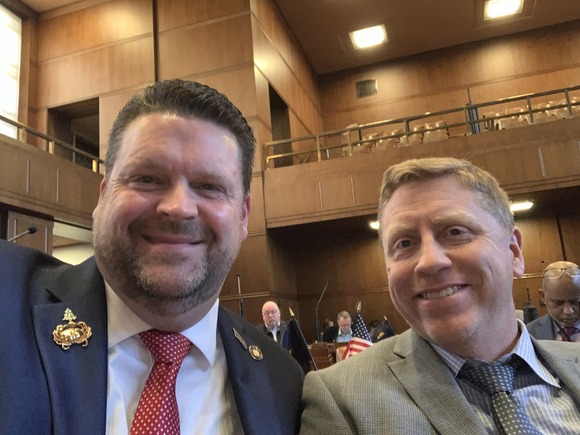 My good friend and colleague, Senator Bonham.
 My friend and colleague, long time County Commissioner and State Senator Hansell is retiring. Thank you for your service.
 Also retiring, my friend and colleague Senator Findley. Lynn joined me in the House in 2018 and I joined him in the Senate in 2023.
 Senator Linthicum and I reminiscing over some bad legislation we were able to stop.
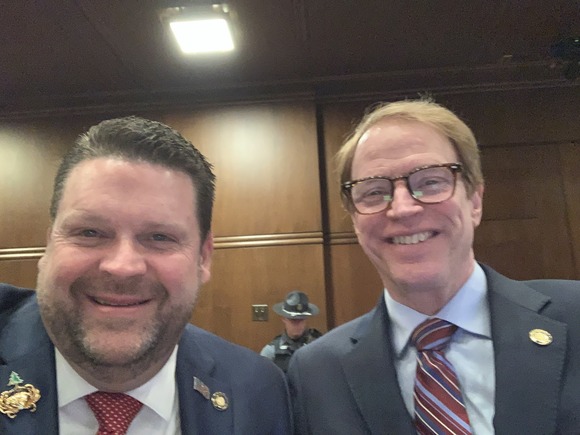 Senate Republican Leader Tim Knopp and I on the final day of the ’24 Legislative Short Session. Thank you for all of your incredible work for Oregonians.
 It is a tradition to have the Senate and the House Sine Die (end session) simultaneously. Then the doors are opened to both chambers together.
 The Capitol is still under seismic renovations.
More to come on next steps for the $35 million dollars in funding we secured for the third Oregon Veterans' Home to be built in Roseburg, $2,865,000 dollars we secured for water, sewer and stormwater projects to increase housing in Sutherlin, my work to expand and increase harvest on our federal forest lands, to provide rural jobs, local timber resources to our mills, while reducing fuel loads and protecting our communities, plus much more.
As always, thank you for the privilege and honor to work for you in the Oregon State Senate. Be safe and God Bless you, your family and your neighbor.
Yours Truly,
 Senator David Brock Smith
Together, We Will Build a Better Oregon
 Senate District 1
Curry, Coos, and Douglas Counties
Southwest Oregon’s Fish, Farm, and Forestry District.
Capitol Phone: 503-986-1701
Capitol Address: 900 Court St. NE, S-316, Salem, Oregon 97301
Email: Sen.DavidBrockSmith@oregonlegislature.gov
Website: http://www.oregonlegislature.gov/smithd
|